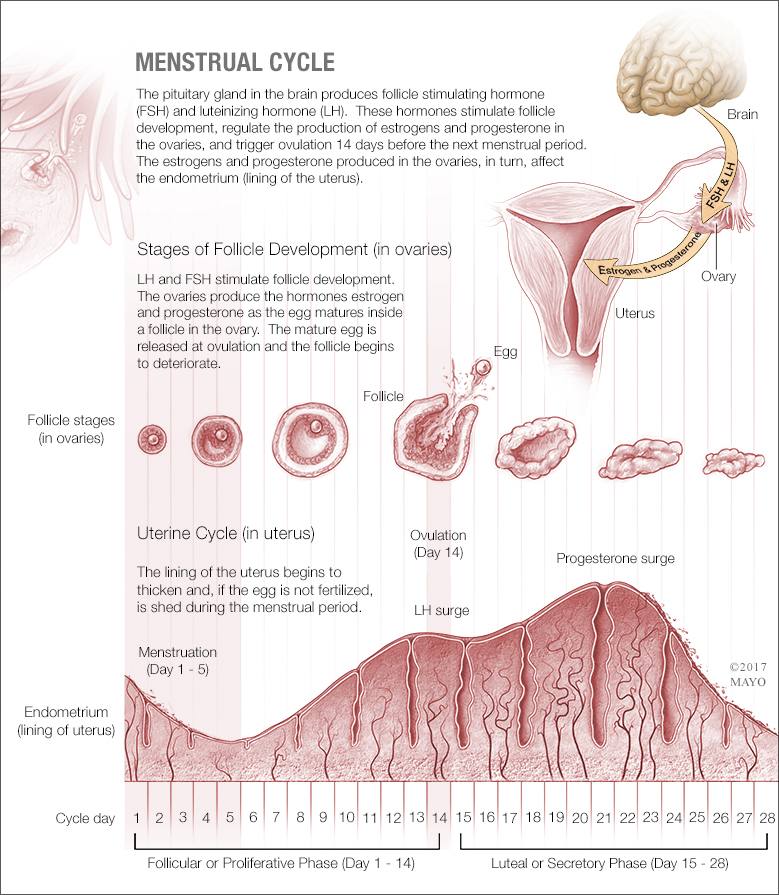-
Mayo Clinic Q and A: Irregular periods can be common at first
 DEAR MAYO CLINIC: My daughter had her first period at 15. That was six months ago, and she hasn’t had a period since. Should I take her to see a health care provider, or is this typical?
DEAR MAYO CLINIC: My daughter had her first period at 15. That was six months ago, and she hasn’t had a period since. Should I take her to see a health care provider, or is this typical?
ANSWER: When they first start, periods in teens are often irregular. It’s not uncommon to go several months without a period within the first year or two of beginning to have menstrual cycles. In your daughter’s situation, a gap of six months at this point probably doesn’t require an evaluation. However, if she goes another three to six months without another period, make an appointment for her to see her health care provider.
During a menstrual cycle, one of the ovaries releases an egg in a process called ovulation. At the same time, hormone changes prepare the uterus for pregnancy. When ovulation happens and the egg isn’t fertilized, the lining of the uterus sheds through the vagina. This is a menstrual period. The average age for periods to begin is 12. But they may start as early as 8 or as late as 16, and still be considered within the normal range.
 For the first few years after menstruation begins, long, irregular cycles are common and not cause for concern. The unpredictability during this time is due to what’s called anovulatory cycles. That means the body isn’t ovulating monthly. In teens, this often happens because their bodies haven’t yet settled into a pattern of regular menstrual cycles. In time, the cycles should become shorter and more predictable.
For the first few years after menstruation begins, long, irregular cycles are common and not cause for concern. The unpredictability during this time is due to what’s called anovulatory cycles. That means the body isn’t ovulating monthly. In teens, this often happens because their bodies haven’t yet settled into a pattern of regular menstrual cycles. In time, the cycles should become shorter and more predictable.
If a girl has her first period and then doesn’t have another one for about a year, an evaluation is appropriate. To see if an underlying medical condition may be responsible for the absence of periods, a health care provider may recommend blood tests or imaging exams, such as an abdominal ultrasound. She or he also might do a pelvic exam.
One condition a health care provider may check for is called polycystic ovary syndrome. Irregular periods are a common symptom of this endocrine system disorder that leads to ovaries with many cysts, or fluid-filled sacs. Other noticeable symptoms may include excessive hair growth and weight gain.
In some elite athletes, such as gymnasts, runners and dancers, periods may stop due to high levels of physical activity coupled with inadequate caloric intake. If that could be the case for your daughter, it must be addressed not only due to cessation of menstrual cycles, but also because it could affect her bone health and other aspects of healthy development.
Also, don’t be surprised if your daughter’s health care provider recommends a pregnancy test — even if she says she hasn’t been sexually active. In women who have regular periods and then don’t have another for an extended length of time, pregnancy is the most common cause. Doing a pregnancy test ensures a comprehensive assessment.
Whether she is sexually active or not, now would be a good time to encourage your daughter to be honest and forthcoming with her health care provider about topics such as sex, menstruation, birth control and other potentially sensitive issues. Emphasize that doing so can help her get the best health care possible. She should know, too, that health care providers are only allowed to share information discussed during an appointment with others if a patient says she’s going to hurt herself or someone else. All other information is confidential, including treatment for sexually transmitted infections and pregnancy.
At this time, reassure your daughter that what she’s experiencing with a lag between her periods is normal. In most cases, girls have a second period within a year of having their first. Foster open and caring communication, so your daughter can feel comfortable talking with you about this important health topic. — Dr. Nusheen Ameenuddin, Community Pediatric and Adolescent Medicine, Mayo Clinic, Rochester, Minnesota







